Installing any software using WSUS - 2
In the continuation of the first part of yosemity, I would like to present a logical continuation and development of LUP - WSUS Package Publisher . Unlike LUP, WSUSPP lives, develops and supports work with Windows Server 2012. In this manual, we will only consider adding updates, creating rules and descriptions of the most common third-party software. Namely:
1) Adobe Flash Player & Adobe Reader
2) 7-zip
3) PDF24 Creator
4) X-Mouse Button Control
5) Adobe Acrobat Reader DC (update from Adobe Reader XI)
Attention! Many pictures, links and information!
Of course, you need a working WSUS and WSUSPP. Configuring WSUSPP is trivial and will not be considered.
Tools that will not be superfluous:
')
- Remote MSI Manager - software for viewing / deleting installed products, installing msi-packages on remote computers. It will be needed to detect Produst Code.
- SuperOrca - Orca development, view / change properties of msi-packages.
- Several test virtual machines, the number depends on your fleet of jobs.
There are examples for these products on the WSUSPP website, you can study it yourself. Links to all resources leave below.
But what's not in the instructions is the documentation for the SCUP directories. Yes, WSUSPP supports third-party software directories. And it is for these Adobe products that there are pre-installed templates.
The same method can be applied to Adobe Flash Player. All the necessary rules are already at the package level, and the update will be installed only where the player was previously installed.
Simple, isn't it? All this, of course, can be done manually.
There are no directories for this software, but there are msi assemblies for 32-bit and 64-bit. Therefore, the task is reduced only to the correct definition of where to put. Almost always, an indicator that the update is installed is the Product Code. You can view this code in msi either by WSUSPP itself ( “Tools” -> “Msi Reader” ), or by third-party programs like SuperOrca. But the indicator of the need for installation will be the OS architecture and product codes of versions 16.00, 16.01 and 9.20.
As you noticed, we update only selected versions.
Upd 2017.01.17 : Thanks for the correction of inaccuracies @perlestius .
And what if users have installed not 2-3 versions of software, but 10? Product codes are not enough. In my case it was PDF24 Creator , a free tool for working with PDF.
2 checks will help us in this: the existence of the file and the version of the file. You can not restrict only to checking for version, because in the absence of a file, it is considered positive. Another subtle point is that PDF24 Creator is a 32-bit application. So, you need to check in both folders Program Files and Program Files (x86).
With msi-packages sorted out. And if only exe is available?
There is such a wonderful free program - X-Mouse Button Control . It allows you to assign many different functions and combinations to your mouse keys. I highly recommend if you use a mouse with 5+ buttons.Updates for this software come in the form of exe-files that need to be intercepted in the Temp directory of the active user. Links to current updates below. Also for the update it is necessary that not a single program process was launched on the system. All this is supported, no conversion to msi is required.
Upd. 2017/02/09 : To download the current update, you can use the links below. Notice that updates go for X32 and X64 versions separately.
Probably many asked this question. And I want to update immediately on the current version. Nothing complicated, just a few extra steps are needed. As well as documentation: Bootstrapper with keys , GUIDs , Adobe properties .
As it turned out, WSUSPP is a very powerful product that can compete with SCCM. Of course, he is not without flaws. These include the impossibility of revising the first steps in the “Custom Update Creator” wizard, as well as the peculiar logic of adding rules. But even with this in mind, WSUS Package Publisher is useful to many system administrators who understand the importance of up-to-date fleet.
1) Adobe Flash Player & Adobe Reader
2) 7-zip
3) PDF24 Creator
4) X-Mouse Button Control
5) Adobe Acrobat Reader DC (update from Adobe Reader XI)
Attention! Many pictures, links and information!
Of course, you need a working WSUS and WSUSPP. Configuring WSUSPP is trivial and will not be considered.
Tools that will not be superfluous:
')
- Remote MSI Manager - software for viewing / deleting installed products, installing msi-packages on remote computers. It will be needed to detect Produst Code.
- SuperOrca - Orca development, view / change properties of msi-packages.
- Several test virtual machines, the number depends on your fleet of jobs.
Adobe Flash Player & Adobe Reader
There are examples for these products on the WSUSPP website, you can study it yourself. Links to all resources leave below.
But what's not in the instructions is the documentation for the SCUP directories. Yes, WSUSPP supports third-party software directories. And it is for these Adobe products that there are pre-installed templates.
Create update
1) “Updates” -> “Manage Catalog Subscribtions ...”
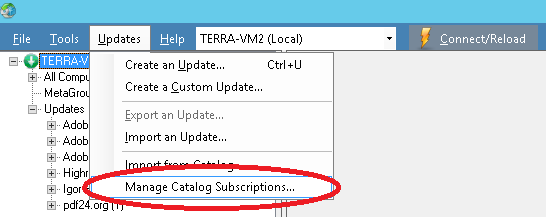
2) Set up directories and their parameters
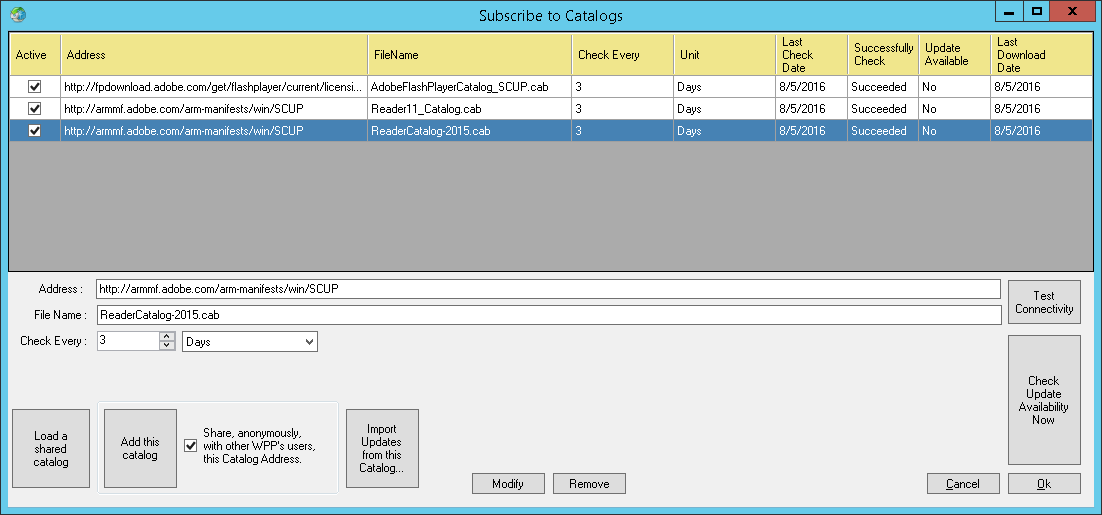
Where:
Load a shared catalog - download the catalog in xml format to the list. By default, a folder with preset
Add this catalog - add a catalog in case you manually make changes to the fields “Address” and “File name”
Check every: - directory update check interval
Modify - save the parameters of the selected directory
Delete - delete the selected directory
Import Updates from this Catalog ... - view available updates. Similar to double clicking on a line. This menu can also be accessed through “Updates” -> “Import from Catalog”
Test Connectivity - Test Connectivity
Check Update Availability Now - check for updates for a selected directory.
3) To add a new update, select the catalog, click "Import Updates from this Catalog ..." -> "Open Catalog" , mark the updates you are interested in and click "Import Selected Updates" .
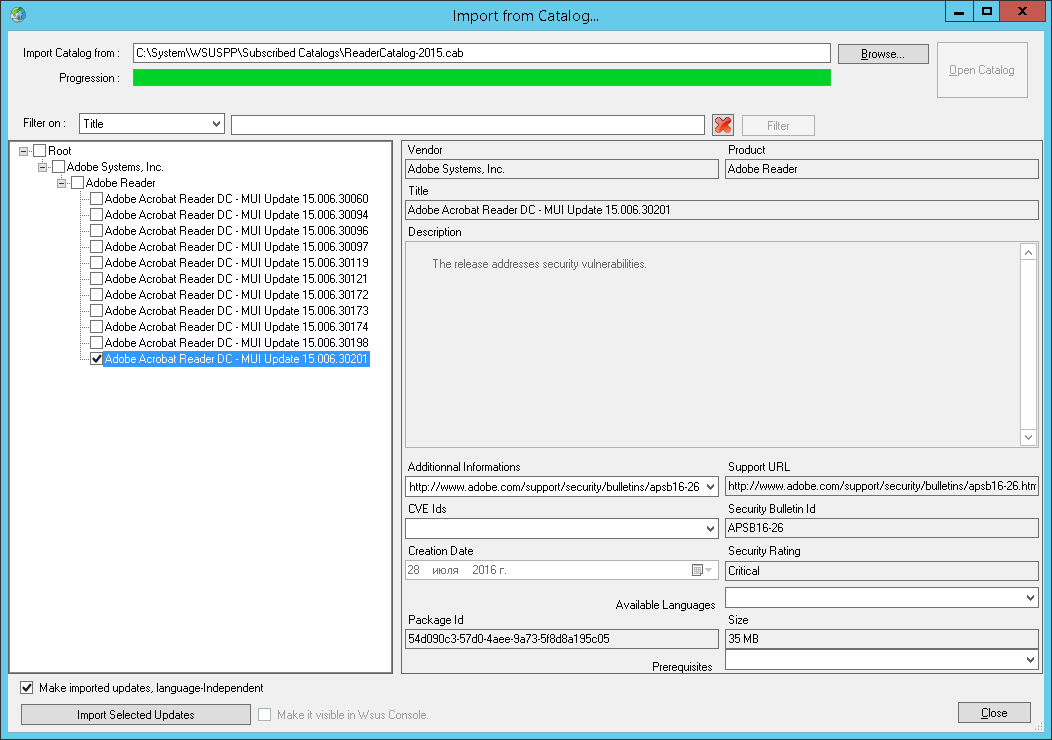
After downloading and publishing, you just need to click "Close" . Update is ready for approval. No additional changes are required, the msp packages already have all the necessary parameters.

2) Set up directories and their parameters

Where:
Load a shared catalog - download the catalog in xml format to the list. By default, a folder with preset
Add this catalog - add a catalog in case you manually make changes to the fields “Address” and “File name”
Check every: - directory update check interval
Modify - save the parameters of the selected directory
Delete - delete the selected directory
Import Updates from this Catalog ... - view available updates. Similar to double clicking on a line. This menu can also be accessed through “Updates” -> “Import from Catalog”
Test Connectivity - Test Connectivity
Check Update Availability Now - check for updates for a selected directory.
3) To add a new update, select the catalog, click "Import Updates from this Catalog ..." -> "Open Catalog" , mark the updates you are interested in and click "Import Selected Updates" .

After downloading and publishing, you just need to click "Close" . Update is ready for approval. No additional changes are required, the msp packages already have all the necessary parameters.
The same method can be applied to Adobe Flash Player. All the necessary rules are already at the package level, and the update will be installed only where the player was previously installed.
Simple, isn't it? All this, of course, can be done manually.
Links
7-Zip Archiver
There are no directories for this software, but there are msi assemblies for 32-bit and 64-bit. Therefore, the task is reduced only to the correct definition of where to put. Almost always, an indicator that the update is installed is the Product Code. You can view this code in msi either by WSUSPP itself ( “Tools” -> “Msi Reader” ), or by third-party programs like SuperOrca. But the indicator of the need for installation will be the OS architecture and product codes of versions 16.00, 16.01 and 9.20.
Create update
Product Code for x86 versions:
9.20 - {23170F69-40C1-2701-0920-000001000000}
16.00 - {23170F69-40C1-2701-1600-000001000000}
1/16 - {23170F69-40C1-2701-1601-000001000000}
February 16 - {23170F69-40C1-2701-1602-000001000000}
1) Create a simple update, specify the file, “Next” .
By the way, I advise you to leave several versions of the old updates.

2) Fill in the "Vendor Name" , "Product Name" , "Title" , etc. "Package Type" should be specified as "Application" .
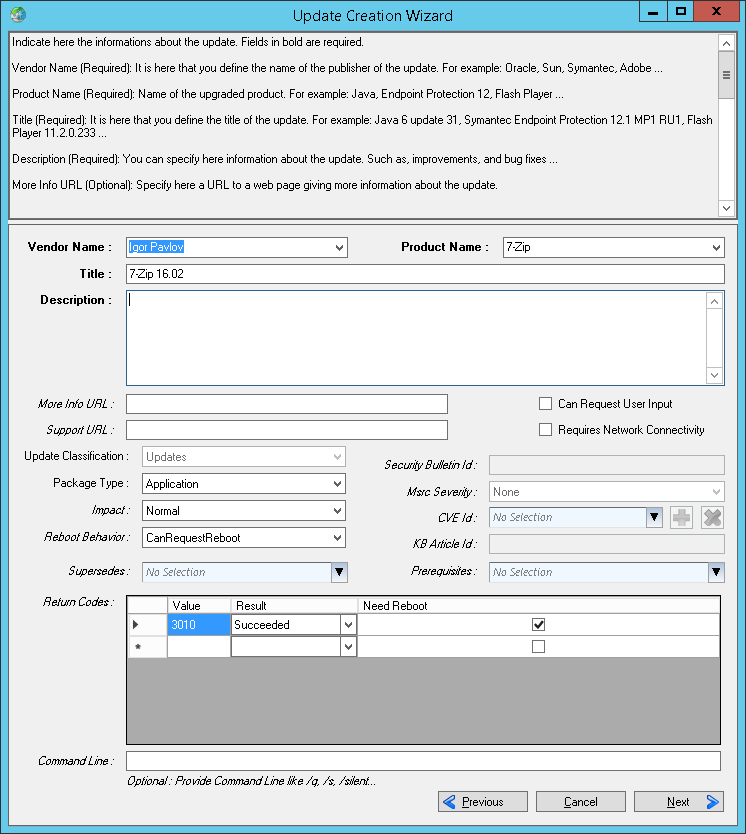
3) Installed section. Here indicates the product code of the package being installed.
"Rule Type: Processor Architecture" -> "Add Rule" -> Architecture x86-> "Ok"
“Rule Type: Msi Produst Installed” -> “Add Rule” -> insert with code for 16.02 -> “Ok” -> “Next”
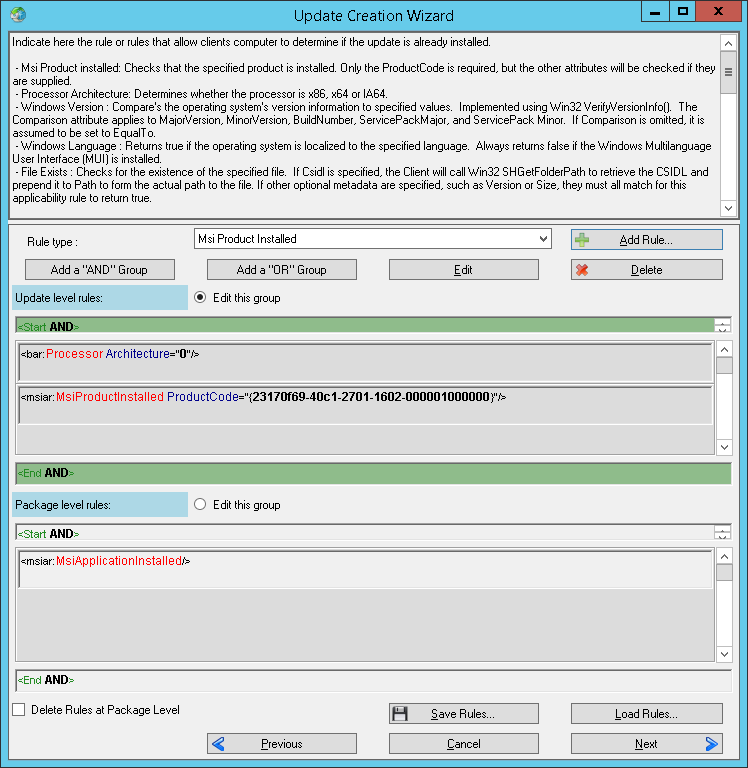
4) Installable section. And here the construction is more complicated.
For 32-bit:
"Rule Type: Processor Architecture" -> "Add Rule" -> Architecture x86-> "Ok"
"Add a" OR "Group"
“Rule Type: Msi Produst Installed” -> “Add Rule” -> Insert Product Code Version 9.20 -> “Ok”
“Rule Type: Msi Produst Installed” -> “Add Rule” -> Insert Product Code Version 16.00 -> “Ok”
“Rule Type: Msi Produst Installed” -> “Add Rule” -> Insert Product Code Version 16.01 -> “Ok” -> “Next”
The result should be the following:
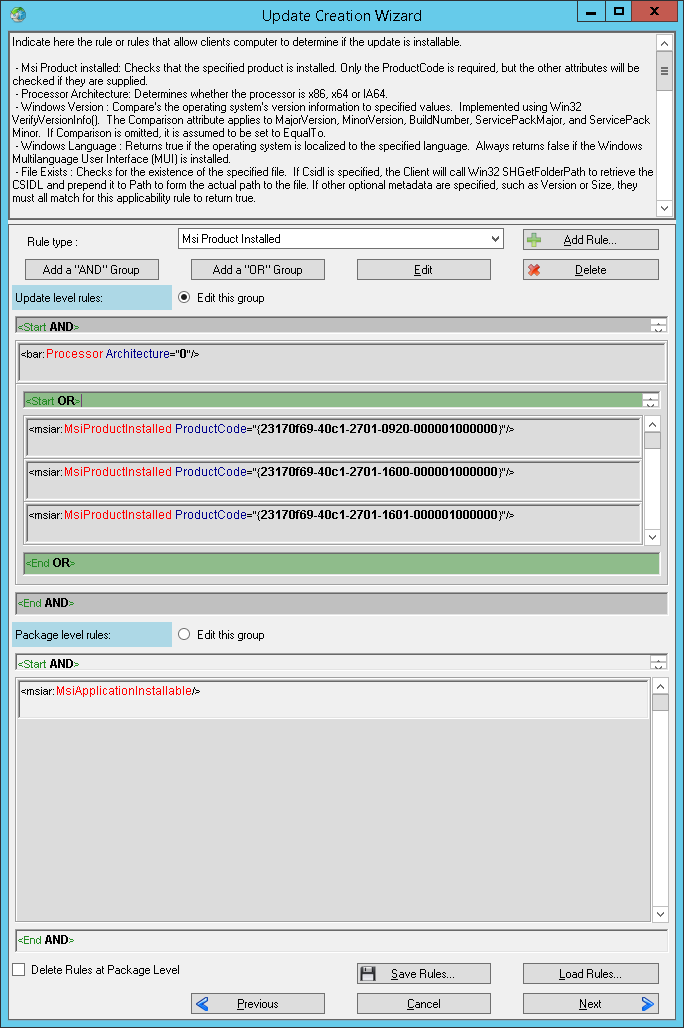
Constructions of rules can be saved and loaded , for this purpose there are corresponding buttons in the bottom.
5) Experienced users can correct the meta-data. We press "Publish" .
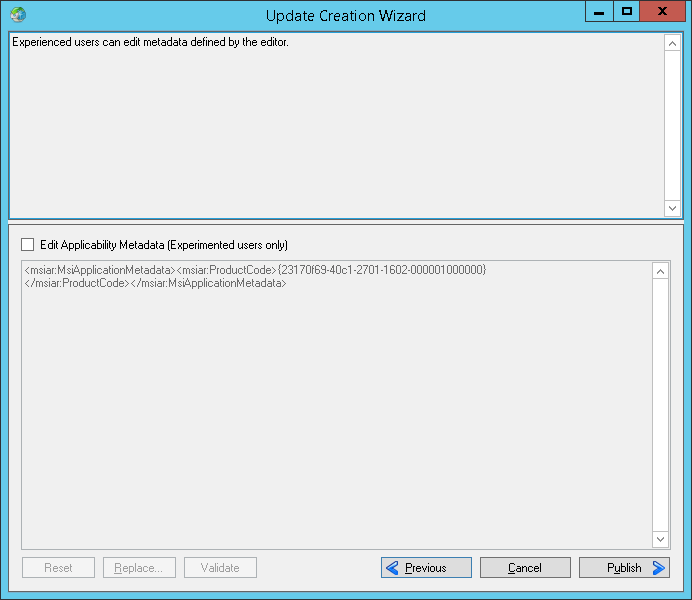
Update published and ready for approval.
For the 64-bit version, the manipulations are similar except for: “Processor Architecture” -> “Architecture x64” and the corresponding product codes.
9.20 - {23170F69-40C1-2701-0920-000001000000}
16.00 - {23170F69-40C1-2701-1600-000001000000}
1/16 - {23170F69-40C1-2701-1601-000001000000}
February 16 - {23170F69-40C1-2701-1602-000001000000}
1) Create a simple update, specify the file, “Next” .
By the way, I advise you to leave several versions of the old updates.

2) Fill in the "Vendor Name" , "Product Name" , "Title" , etc. "Package Type" should be specified as "Application" .

3) Installed section. Here indicates the product code of the package being installed.
"Rule Type: Processor Architecture" -> "Add Rule" -> Architecture x86-> "Ok"
“Rule Type: Msi Produst Installed” -> “Add Rule” -> insert with code for 16.02 -> “Ok” -> “Next”

4) Installable section. And here the construction is more complicated.
For 32-bit:
"Rule Type: Processor Architecture" -> "Add Rule" -> Architecture x86-> "Ok"
"Add a" OR "Group"
“Rule Type: Msi Produst Installed” -> “Add Rule” -> Insert Product Code Version 9.20 -> “Ok”
“Rule Type: Msi Produst Installed” -> “Add Rule” -> Insert Product Code Version 16.00 -> “Ok”
“Rule Type: Msi Produst Installed” -> “Add Rule” -> Insert Product Code Version 16.01 -> “Ok” -> “Next”
The result should be the following:

Constructions of rules can be saved and loaded , for this purpose there are corresponding buttons in the bottom.
5) Experienced users can correct the meta-data. We press "Publish" .

Update published and ready for approval.
For the 64-bit version, the manipulations are similar except for: “Processor Architecture” -> “Architecture x64” and the corresponding product codes.
As you noticed, we update only selected versions.
Upd 2017.01.17 : Thanks for the correction of inaccuracies @perlestius .
PDF24 Creator
And what if users have installed not 2-3 versions of software, but 10? Product codes are not enough. In my case it was PDF24 Creator , a free tool for working with PDF.
2 checks will help us in this: the existence of the file and the version of the file. You can not restrict only to checking for version, because in the absence of a file, it is considered positive. Another subtle point is that PDF24 Creator is a 32-bit application. So, you need to check in both folders Program Files and Program Files (x86).
Create update
Product Code for version 7.9.0 - 26364d59-91dd-4b5f-a521-8c7d35e1743c
The first 2 steps are similar to those from the 7-Zip example.
3) Installed section.
“Rule Type: Msi Produst Installed” -> “Add Rule” -> Insert Product Code -> “Ok” -> “Next”
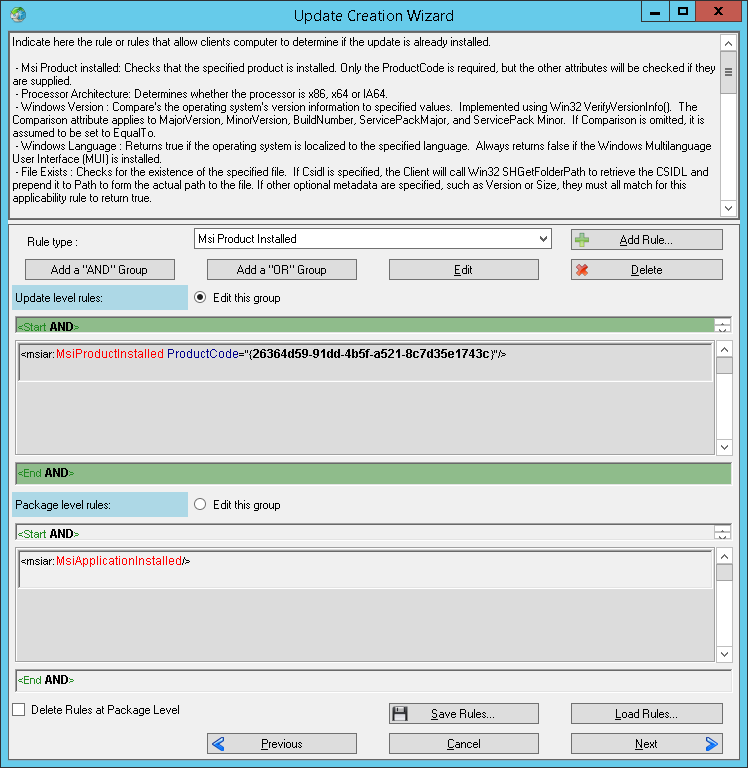
4) Installable section.
Translate the basic rule to "Start OR" . To do this, double click on the “Start AND” bar, or click on the “Edit” button.
“Add a„ AND “Group"
“Rule Type: File Exists” -> “Add Rule” -> “Known Folder: PROGRAM_FILES”, “File Path: PDF24 \ pdf24.exe” -> “Ok”
“Rule Type: File Version” -> “Add Rule” -> “Wellknown directory: PROGRAM_FILES”, “File Path: PDF24 \ pdf24.exe”, “Comprasion: Less Then”, “File Version: 7.9.0.0” -> “Ok”
Translate selection to main rule
“Add a„ AND “Group"
“Rule Type: File Exists” -> “Add Rule” -> “Known Folder: PROGRAM_FILESX86”, “File Path: PDF24 \ pdf24.exe” -> “Ok”
“Rule Type: File Version” -> “Add Rule” -> “Wellknown directory: PROGRAM_FILESX86”, “File Path: PDF24 \ pdf24.exe”, “Comprasion: Less Then”, “File Version: 7.9.0.0” -> “Ok”
You can also specify the file through the full path.
As a result, you should have the following:
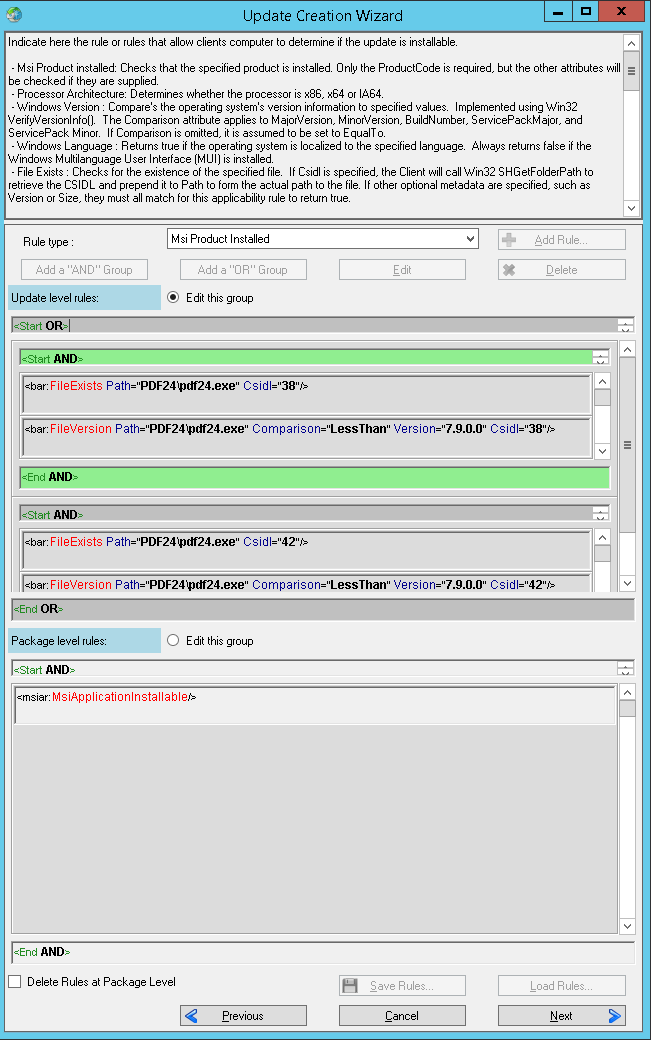
5) Experienced users can correct the meta-data. We click "Publish"
The first 2 steps are similar to those from the 7-Zip example.
3) Installed section.
“Rule Type: Msi Produst Installed” -> “Add Rule” -> Insert Product Code -> “Ok” -> “Next”

4) Installable section.
Translate the basic rule to "Start OR" . To do this, double click on the “Start AND” bar, or click on the “Edit” button.
“Add a„ AND “Group"
“Rule Type: File Exists” -> “Add Rule” -> “Known Folder: PROGRAM_FILES”, “File Path: PDF24 \ pdf24.exe” -> “Ok”
“Rule Type: File Version” -> “Add Rule” -> “Wellknown directory: PROGRAM_FILES”, “File Path: PDF24 \ pdf24.exe”, “Comprasion: Less Then”, “File Version: 7.9.0.0” -> “Ok”
Translate selection to main rule
“Add a„ AND “Group"
“Rule Type: File Exists” -> “Add Rule” -> “Known Folder: PROGRAM_FILESX86”, “File Path: PDF24 \ pdf24.exe” -> “Ok”
“Rule Type: File Version” -> “Add Rule” -> “Wellknown directory: PROGRAM_FILESX86”, “File Path: PDF24 \ pdf24.exe”, “Comprasion: Less Then”, “File Version: 7.9.0.0” -> “Ok”
You can also specify the file through the full path.
As a result, you should have the following:

5) Experienced users can correct the meta-data. We click "Publish"
With msi-packages sorted out. And if only exe is available?
X-Mouse Button Control
There is such a wonderful free program - X-Mouse Button Control . It allows you to assign many different functions and combinations to your mouse keys. I highly recommend if you use a mouse with 5+ buttons.
Create update
Such updates are created through “Updates” -> “Create a Custom Update” .
The necessary actions are added by double clicking. If you make a mistake in the sequence, you can move the string up / down, right-click on the action.
1) First, we throw in all the actions for a full installation.
"Allow to kill process by his name" -> XMouseButtonControl -> "Ok" (the name is specified without extension)
“Allow to execute a file” -> XMBCUpdate_2.13.1.exe -> “Ok” -> “Ok” (the name is arbitrary, but the file with this name should be used in paragraph 2)
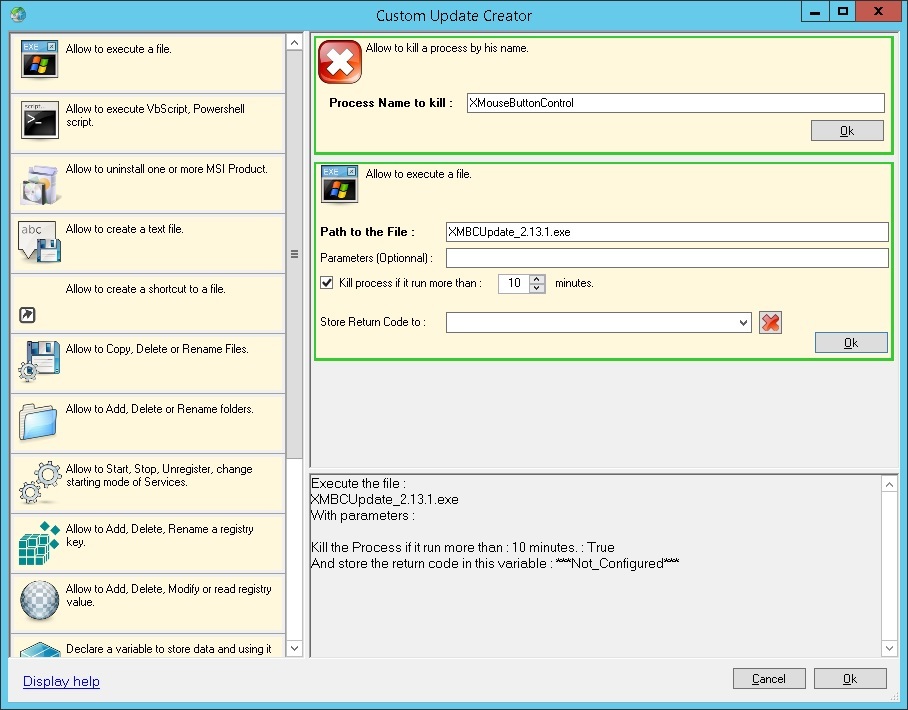
2) In the next window you need to add an exe file. The rest of the files do not touch.
“Add Files ...” -> XMBCUpdate_2.13.1.exe -> “Ok” -> “Next”
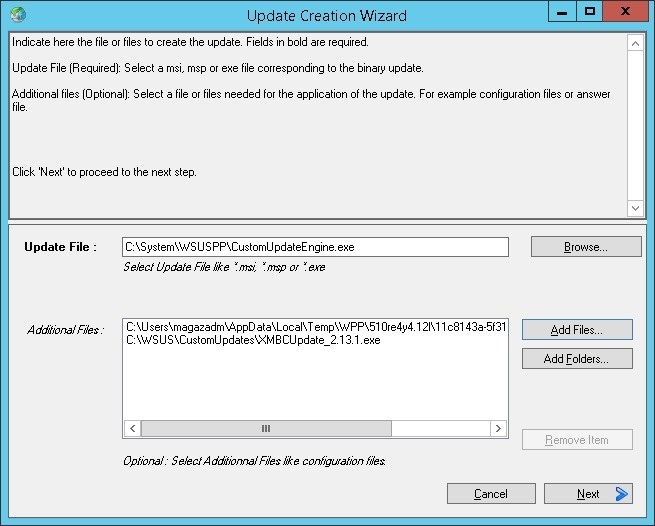
3) Fill in the fields “Vendor Name” , “Product Name” , “Title” , etc. Command Line does not change / delete.

4) We will consider the update installed by checking the file version, since Product Code is not registered in the system. For x32 and x64 it is installed equally in Program Files .
“Rule Type: File Version” -> “Add Rule” -> “Wellknown directory: PROGRAM_FILES”, “File Path: High Resolution Enterprises \ X-Mouse Button Control \ XMouseButtonControl.exe”, “Comprasion: Equal To”, “File Version : 2.13.1.0 ”->“ Ok ”->“ Next ”
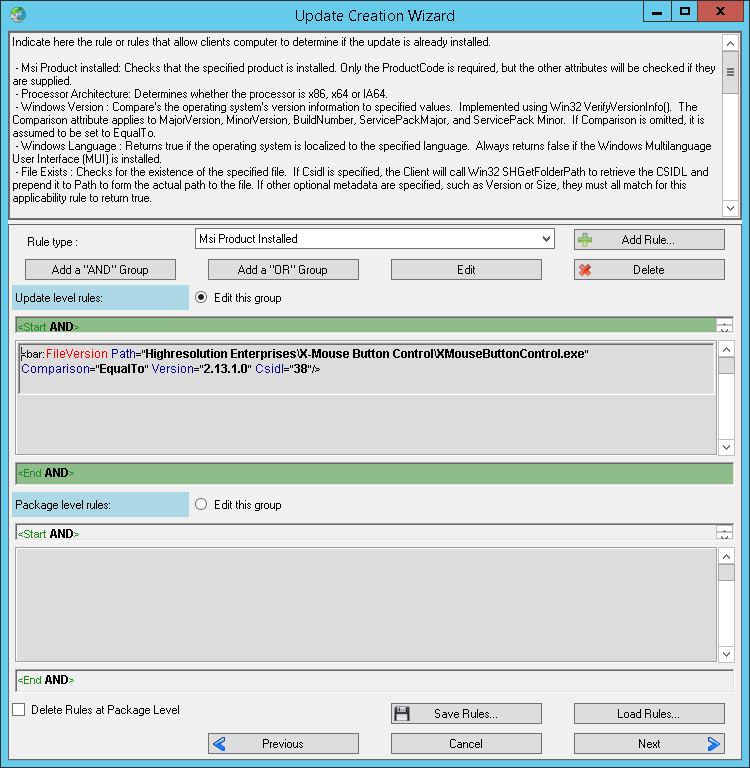
5) The need for installation is checked as in the previous example.
“Rule Type: File Exists” -> “Add Rule” -> “Known Folder: PROGRAM_FILES”, “Highresolution Enterprises \ X-Mouse Button Control \ XMouseButtonControl.exe” -> “Ok”
“Rule Type: File Version” -> “Add Rule” -> “Wellknown directory: PROGRAM_FILES”, “File Path: High Resolution Enterprises \ X-Mouse Button Control \ XMouseButtonControl.exe”, “Comprasion: Less Then”, “File Version : 2.13.1.0 ”->“ Ok ”->“ Next ”

6) Experienced users can correct the meta-data. We press "Publish" .
The necessary actions are added by double clicking. If you make a mistake in the sequence, you can move the string up / down, right-click on the action.
1) First, we throw in all the actions for a full installation.
"Allow to kill process by his name" -> XMouseButtonControl -> "Ok" (the name is specified without extension)
“Allow to execute a file” -> XMBCUpdate_2.13.1.exe -> “Ok” -> “Ok” (the name is arbitrary, but the file with this name should be used in paragraph 2)

2) In the next window you need to add an exe file. The rest of the files do not touch.
“Add Files ...” -> XMBCUpdate_2.13.1.exe -> “Ok” -> “Next”

3) Fill in the fields “Vendor Name” , “Product Name” , “Title” , etc. Command Line does not change / delete.

4) We will consider the update installed by checking the file version, since Product Code is not registered in the system. For x32 and x64 it is installed equally in Program Files .
“Rule Type: File Version” -> “Add Rule” -> “Wellknown directory: PROGRAM_FILES”, “File Path: High Resolution Enterprises \ X-Mouse Button Control \ XMouseButtonControl.exe”, “Comprasion: Equal To”, “File Version : 2.13.1.0 ”->“ Ok ”->“ Next ”

5) The need for installation is checked as in the previous example.
“Rule Type: File Exists” -> “Add Rule” -> “Known Folder: PROGRAM_FILES”, “Highresolution Enterprises \ X-Mouse Button Control \ XMouseButtonControl.exe” -> “Ok”
“Rule Type: File Version” -> “Add Rule” -> “Wellknown directory: PROGRAM_FILES”, “File Path: High Resolution Enterprises \ X-Mouse Button Control \ XMouseButtonControl.exe”, “Comprasion: Less Then”, “File Version : 2.13.1.0 ”->“ Ok ”->“ Next ”

6) Experienced users can correct the meta-data. We press "Publish" .
Upd. 2017/02/09 : To download the current update, you can use the links below. Notice that updates go for X32 and X64 versions separately.
Direct download links
Actual on 2019/03/05 links:
highrez.co.uk/downloads/XMBCUpdateX64.2.18.5.exe or highrez.co.uk/downloads/XMBCUpdateX86.2.18.5.exe
highrez.co.uk/downloads/XMBCUpdateX64.2.18.5.exe or highrez.co.uk/downloads/XMBCUpdateX86.2.18.5.exe
Upgrade Adobe Reader XI to Adobe Acrobat Reader DC
Probably many asked this question. And I want to update immediately on the current version. Nothing complicated, just a few extra steps are needed. As well as documentation: Bootstrapper with keys , GUIDs , Adobe properties .
Training
First you need to unzip exe. This is done from the command line using the -sfx_o “unpacking path” -sfx_ne parameters (instead of sfx , nos can be used).
In my case it turns out like this:
"C: \ WSUS \ CustomUpdates \ Adobe Acrobat Reader \ AcroRdr20151500630033_MUI.exe" -sfx_o "C: \ WSUS \ CustomUpdates \ Adobe AcrobatReader \ AcroRdr20151500630033_MUI" -sfx_ne
In the folder with the unpacked content, you need to place the current patch (at the time of writing, the article - 15.006.30201).
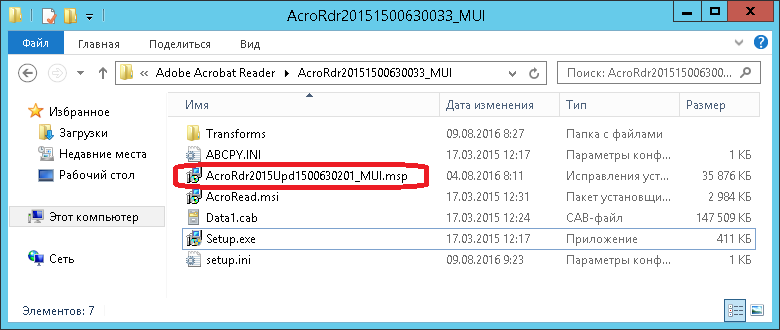
And finally, edit the Setup.ini file, adding 2 lines:
[Startup]
CmdLine = / sAll / rs / msi UPDATE_MODE = 0 EULA_ACCEPT = YES
[Product]
PATCH = AcroRdr2015Upd1500630201_MUI.msp

In my case it turns out like this:
"C: \ WSUS \ CustomUpdates \ Adobe Acrobat Reader \ AcroRdr20151500630033_MUI.exe" -sfx_o "C: \ WSUS \ CustomUpdates \ Adobe AcrobatReader \ AcroRdr20151500630033_MUI" -sfx_ne
In the folder with the unpacked content, you need to place the current patch (at the time of writing, the article - 15.006.30201).

And finally, edit the Setup.ini file, adding 2 lines:
[Startup]
CmdLine = / sAll / rs / msi UPDATE_MODE = 0 EULA_ACCEPT = YES
[Product]
PATCH = AcroRdr2015Upd1500630201_MUI.msp

Create update
0) “Updates” -> “Create a Custom Update” .
1) To fully automate the process, you need to complete the AcroRd32.exe process.
"Allow to kill process by his name" -> AcroRd32 -> "Ok" (the name is specified without extension)
“Allow to execute a file” -> AcroRdr20151500630033_MUI \ Setup.exe -> “Ok” -> “Ok” (as in point 2, the folder will be indicated, the path to the file is specified with its account).
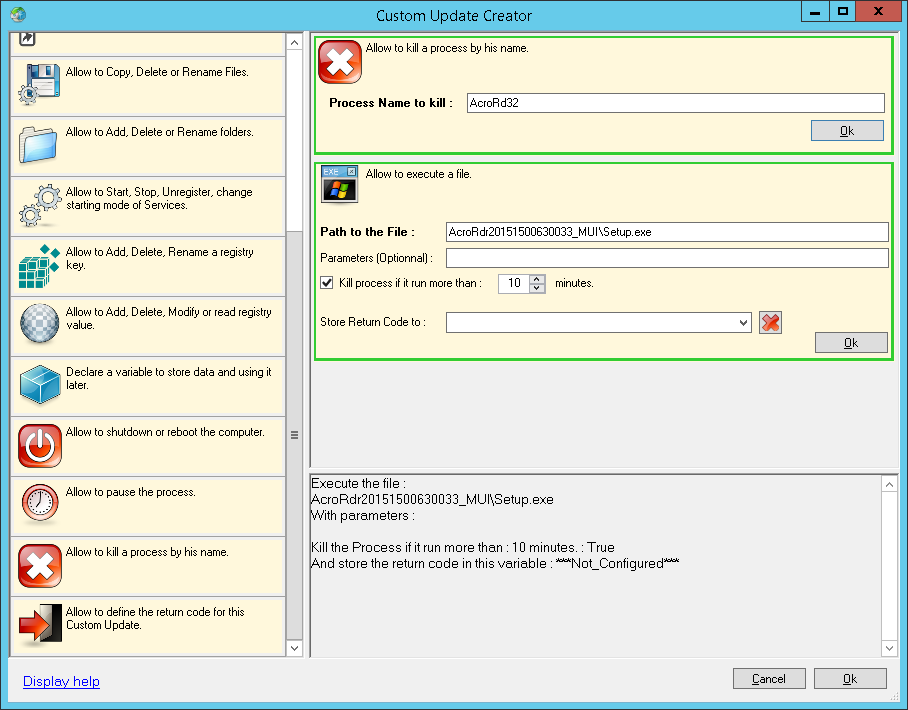
Additional parameters are not used, since everything is already specified in Setup.ini
2) Add a folder
“Add Folders ...” -> AcroRdr20151500630033_MUI -> “Ok” -> “Next”
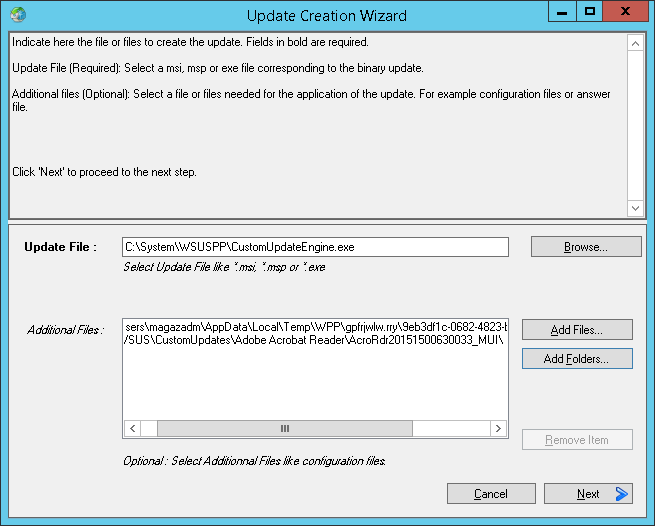
3) Fill in the fields “Vendor Name” , “Product Name” , “Title” , etc. Command Line does not change / delete.
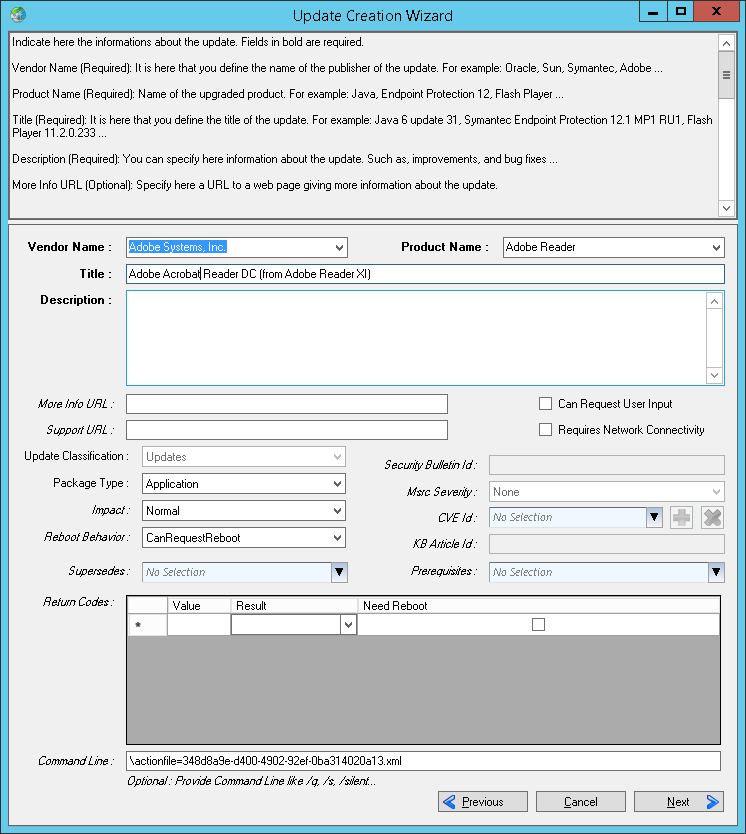
4) Consider the update installed by checking the Product Code. It does not change when installing new patches.
“Rule Type: Msi Produst Installed” -> “Add Rule” -> AC76BA86-7AD7-FFFF-7B44-AE0F06755100 -> “Ok” -> “Next”
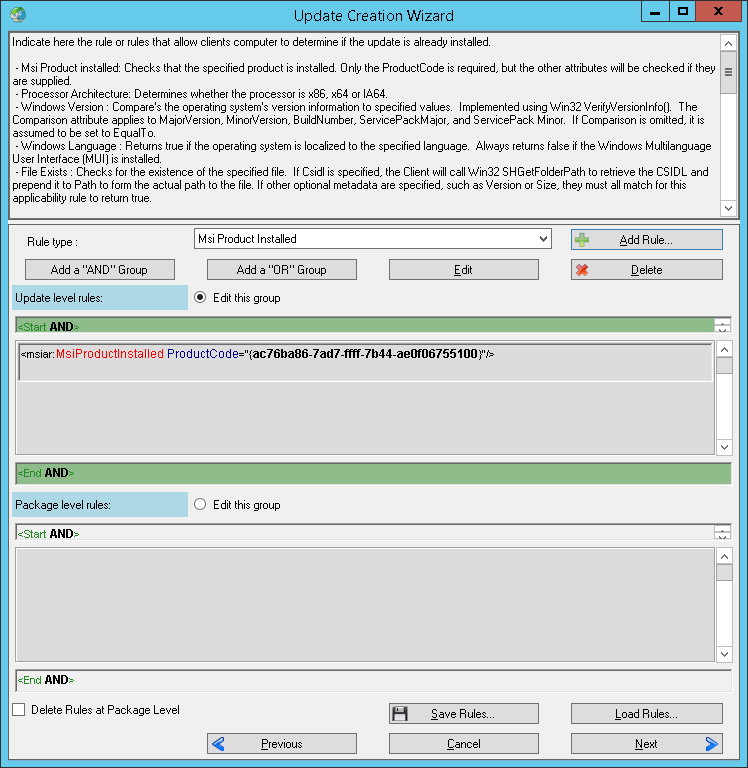
5) The need for installation is checked in the same way, but also according to the OS version (the DC version supports Windows 7 and newer).
"Rule Type: Msi Produst Installed" -> "Add Rule" -> AC76BA86-7AD7-1049-7B44-AB0000000001 -> "Ok"
“Rule Type: Windows Version” -> “Add Rule” -> “Comparison: Greater Then or Equal To”, “Easy Selection: Windows 7” -> “Ok” -> “Next”
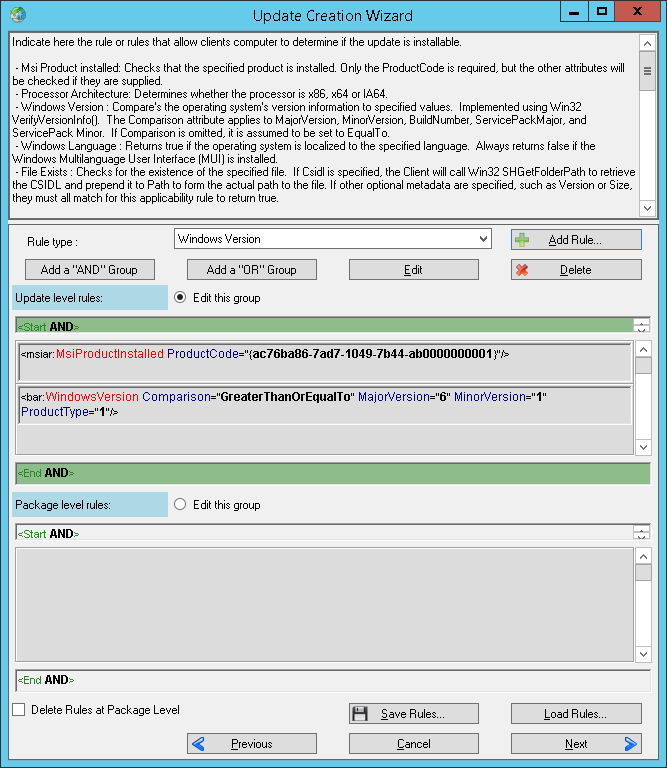
6) Experienced users can correct the meta-data. We press "Publish" .
PS: The contents of CmdLine can be moved from Setup.ini to Parameters (Optional) in step 1 .
1) To fully automate the process, you need to complete the AcroRd32.exe process.
"Allow to kill process by his name" -> AcroRd32 -> "Ok" (the name is specified without extension)
“Allow to execute a file” -> AcroRdr20151500630033_MUI \ Setup.exe -> “Ok” -> “Ok” (as in point 2, the folder will be indicated, the path to the file is specified with its account).

Additional parameters are not used, since everything is already specified in Setup.ini
2) Add a folder
“Add Folders ...” -> AcroRdr20151500630033_MUI -> “Ok” -> “Next”

3) Fill in the fields “Vendor Name” , “Product Name” , “Title” , etc. Command Line does not change / delete.

4) Consider the update installed by checking the Product Code. It does not change when installing new patches.
“Rule Type: Msi Produst Installed” -> “Add Rule” -> AC76BA86-7AD7-FFFF-7B44-AE0F06755100 -> “Ok” -> “Next”

5) The need for installation is checked in the same way, but also according to the OS version (the DC version supports Windows 7 and newer).
"Rule Type: Msi Produst Installed" -> "Add Rule" -> AC76BA86-7AD7-1049-7B44-AB0000000001 -> "Ok"
“Rule Type: Windows Version” -> “Add Rule” -> “Comparison: Greater Then or Equal To”, “Easy Selection: Windows 7” -> “Ok” -> “Next”

6) Experienced users can correct the meta-data. We press "Publish" .
PS: The contents of CmdLine can be moved from Setup.ini to Parameters (Optional) in step 1 .
As it turned out, WSUSPP is a very powerful product that can compete with SCCM. Of course, he is not without flaws. These include the impossibility of revising the first steps in the “Custom Update Creator” wizard, as well as the peculiar logic of adding rules. But even with this in mind, WSUS Package Publisher is useful to many system administrators who understand the importance of up-to-date fleet.
Source: https://habr.com/ru/post/307032/
All Articles